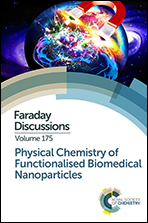The EFG Rosetta Stone: Translating between DFT calculations and solid state NMR experiments
IF 3.3
3区 化学
Q2 CHEMISTRY, PHYSICAL
引用次数: 0
Abstract
We present a comprehensive study on the best practices for integrating first principles simulations in experimental quadrupolar solid-state nuclear magnetic resonance (SS-NMR), exploiting the synergies between theory and experiment for achieving the optimal interpretation of both. Most high performance materials (HPM), such as battery electrodes, exhibit complex SS-NMR spectra due to dynamic effects or amorphous phases. NMR crystallography for such challenging materials requires reliable, accurate, efficient computational methods for calculating NMR observables from first principles for the transfer between material structure models and the interpretation of their experimental SS-NMR spectra. NMR-active nuclei within HPMs are routinely probed by their chemical shielding anisotropy (CSA). However, several nuclear isotopes of interest, e.g. 7Li and 27Al, have a nuclear quadrupole and experience additional interactions with the surrounding electric field gradient (EFG). The quadrupolar interaction is a valuable source of information about atomistic structure and in particular local symmetry, complementing the CSA. As such, there is a range of different methods and codes to choose from for calculating EFGs, from all-electron to plane wave methods. We benchmark the accuracy of different simulation strategies for computing the EFG tensor of quadrupolar nuclei with plane wave density functional theory (DFT) and study the impact of the material structure, and the details of the simulation strategy. Especially for small nuclei with few electrons, such as 7Li, we can show that the choice of physical approximations and simulation parameters has a large effect on the transferability of the simulations results. To the best of our knowledge, we present the first comprehensive reference scale and literature survey for 7Li quadrupolar couplings. The results allow us to establish practical guidelines for developing the best simulation strategy for correlating DFT to experimental data extracting the maximum benefit and information from both, thereby advancing further research into HPMs.EFG 罗塞塔石碑:DFT 计算与固态 NMR 实验之间的转换
我们全面研究了将第一性原理模拟融入四极固态核磁共振(SS-NMR)实验的最佳实践,利用理论与实验之间的协同作用实现两者的最佳解释。大多数高性能材料(HPM),如电池电极,都会因动态效应或非晶相而表现出复杂的 SS-NMR 光谱。此类高难度材料的 NMR 晶体学需要可靠、准确、高效的计算方法,以便根据第一性原理计算 NMR 观察值,在材料结构模型和 SS-NMR 光谱实验解释之间进行转换。HPMs 中的 NMR 活性核通常通过其化学屏蔽各向异性 (CSA) 进行探测。然而,一些感兴趣的核同位素(如 7Li 和 27Al)具有核四极,会与周围的电场梯度(EFG)发生额外的相互作用。四极相互作用是原子结构,特别是局部对称性的重要信息来源,是对 CSA 的补充。因此,计算 EFG 有一系列不同的方法和代码可供选择,从全电子到平面波方法。我们对利用平面波密度泛函理论(DFT)计算四极核 EFG 张量的不同模拟策略的准确性进行了基准测试,并研究了材料结构和模拟策略细节的影响。特别是对于电子数很少的小原子核,如 7Li,我们可以证明物理近似和模拟参数的选择对模拟结果的可移植性有很大影响。据我们所知,我们首次提出了 7Li 四极耦合的全面参考尺度和文献调查。这些结果使我们能够为制定最佳模拟策略制定切实可行的指导原则,以便将 DFT 与实验数据关联起来,从两者中提取最大的效益和信息,从而推动 HPMs 的进一步研究。
本文章由计算机程序翻译,如有差异,请以英文原文为准。
求助全文
约1分钟内获得全文
求助全文
来源期刊

Faraday Discussions
化学-物理化学
自引率
0.00%
发文量
259
期刊介绍:
Discussion summary and research papers from discussion meetings that focus on rapidly developing areas of physical chemistry and its interfaces
 求助内容:
求助内容: 应助结果提醒方式:
应助结果提醒方式:


